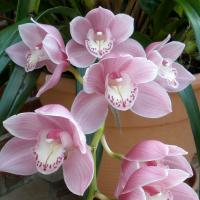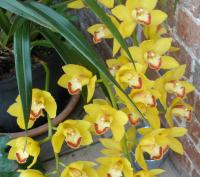How to Care for Cymbidium Orchids
 Cymbidium, or Boat Orchid
Cymbidium, or Boat OrchidThe Cymbidium genus of Orchid, or Boat Orchid as it is commonly known, is not as popular as the Phalaenopsis, but still proves a reliable favourite.
As Christmas and New Year approaches people often buy orchids as presents, especially Cymbidiums as their flowering season is from December to April; compared to Phalaenopsis that flower all the year round. In this article, we hope to provide some tips on what to look for when buying a Cymbidium (or indeed any orchid, except the kind which grow in soil, a cold-frame or in the garden).
Growing Medium
The medium in which Orchids grow in captivity is called compost. However, this term can be misleading as Orchid compost is not really compost at all, but mainly hard chunky bark often with some charcoal and pearlite added. Many commercially sold Orchids are potted in soft materials such as Rockwool. This may be all right for a few months, but will likely lead to root rot eventually and as such should be re-potted once new leaf growth begins.
Plant Condition
The leaves should be shiny with no peppering of white spots on the underside (caused by spider mite). The leaf tips should not be brown.
The flower spikes should be neatly tied to a stake and preferably have a few unopened buds at the end of each spike. This shows that the spike is fresh and will last for 2 months or so; with a fully-opened spike it is difficult to tell how old it is.
Growing Conditions
Give the Orchid maximum light during the winter and keep away from drafts.
Place the plant with its flower spikes facing the light, so that when the last buds open they will naturally turn to the light, otherwise they may face the wrong way when they open.
A key risk when bringing a new Orchid home is that of bud drop as your household temperature and conditions will not be the same as that of a commercial greenhouse. Avoid letting the plant get too cold at night and do not over water before all the buds have opened.
Watering
 Commercially, Cymbidiums will have been grown quite wet and will tolerate damp roots much more than Phalaenopsis do and therefore do not need to dry out between waterings.
Commercially, Cymbidiums will have been grown quite wet and will tolerate damp roots much more than Phalaenopsis do and therefore do not need to dry out between waterings.
Cymbidiums can be watered from the top or bottom with tepid water and fed with very week feed every other time. Tap water is fine, but let it stand for 24 hours to get to room temperature. Flush plenty of water through, then hold it until the excess drains out.
Pruning and Feeding
When the last flowers have died, cut off the flower spike completely (unlike Phalaenopsis where you cut the stem just below where the last flower has died).
In Spring you should see new leaf growth coming from the base of the newest bulb. When these growths are 6 (15cm) long give them plenty of water, along with feed (either weak fertiliser such as Tomorite, or an orchid feed at the recommended strength). The aim is to produce bulbs as big as those from which the flower spikes originally emerged. Smaller bulbs will not have enough 'umph' to produce flower spikes.
Leaf Maintenance
In a home environment leaves will inevitably get dusty and require wiping every few months.
With Cymbidiums, lightly grasp the lower end of a leaf to prevent it from being pulled out when you wipe it. Then, with a damp cloth covering both sides of the leaf, gently slide it from bottom to top so that dust is removed from the whole leaf.
Trim off any brown tips to make it look nicer and remove any old brown husks left behind attached to the bulbs where leaves have died and fallen off.
Continuing Care
From June onwards you can place Cymbidiums outside in dappled or partial shade, with plenty of watering and feeding to plump up the bulbs. They should be brought in again in mid September.
If you are lucky you should see rounded flower spikes emerging from the base of bulbs, they may even burst their way through the actual bulb. As the flower spikes get longer, train them upwards by gently tying to a stake, but do not disturb them too much from their original direction of growth all at once, or you may snap them off. Do this every few days bit by bit until you have the flower spikes in the desired position.
This article was written by Dr Derek Copley, Chairman of the Bournemouth Orchid Society.
Filed under House Plants.

